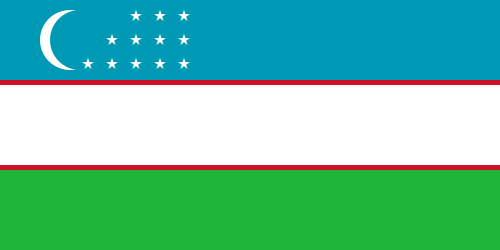- Blue Stripe: Positioned at the flag's zenith, the azure blue stripe is a symbolic representation of the heavens and the celestial expanse. Within its vibrant hue lies the concept of infinite possibilities, hope, and an unbounded potential for advancement and evolution. The blue pigment, infused with the collective optimism and ambitions of the Uzbek populace, encapsulates the nation's fervent pursuit of a brighter tomorrow.
- White Stripe: Occupying the flag's central position, the pristine white stripe stands as an emblem of purity, tranquility, and concord. An epitome of harmonious coexistence among myriad ethnicities, cultures, and religious beliefs within Uzbekistan, this expanse of white evokes the unifying ethos of unity, tolerance, and empathy amongst diverse communities.
- Green Stripe: Bedecking the lowermost portion of the flag, the lush green stripe pays homage to the fertile landscapes and copious natural resources adorning Uzbekistan's geography. A tribute to the nation's agrarian heritage, it extols the significance of cultivation, nature's bounty, and sustainable development. This verdant hue also resonates with themes of prosperity, rejuvenation, and ceaseless growth.
- Crescent Moon: Nestled within the blue stripe's embrace, the crescent moon—a symbol deeply ingrained in Islamic tradition—serves as a representation of spirituality, faith, and the Islamic legacy interwoven with Uzbekistan's identity. The crescent's curvature mirrors the journey of the Uzbek people towards enlightenment, progress, and self-realization.
- Twelve Stars: Arrayed in a graceful semi-circular arc around the crescent moon, the twelve stars hold profound significance. Manifesting the twelve months of the Islamic lunar calendar, they forge a link to Uzbekistan's Islamic heritage and cultural roots. As celestial markers of the passage of time, these stars also bear testament to the cyclical nature of existence, embodying a tapestry of life's rhythms.
Formally adopted on November 18, 1991, shortly preceding Uzbekistan's emergence from the Soviet Union, the flag encapsulates the essence of the nation's values, chronicles its history, and encapsulates its aspirations. It signifies the dawning of a transformative era for the Uzbek people, signifying a momentous stride towards self-determination and a fresh chapter in the annals of their nation's narrative.
Meaningful Composition:In an orchestration of colors, symbols, and elements, the flag achieves a harmonious symphony that narrates a tale of solidarity, advancement, and cultural identity. The amalgamation of blue, white, and green hues conveys a panoramic panorama of Uzbekistan's past, present, and future. This tableau accentuates the nation's intrinsic beauty, cultural diversity, and devotion to its religious heritage.
In summation, the Uzbekistan flag stands as an animated portrayal of the nation's aspirations and principles. The fusion of its colors and symbols unites to depict a nation that treasures peace, harmony, progress, and an intricate tapestry of cultural heritage. This emblem unfurls as a source of pride, instantly recognizable, embodying the resolute spirit of Uzbekistan and its populace.
Last Updated on: August 01, 2023